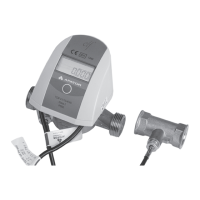- 5 -
The calculation formula is:
Q - quantity of consumed heat
dV - volume of flowing water
k - temperature coefficient of water
t1 - supply water temperature
t2 - return water temperature
Another value, which is called the resolver metrological test, is calculated to evaluate the metrological
class of the electronic system as a stand-alone resolver for the heat meter. The calculations of instanta-
neous water volume flow and instantaneous power are performed in the heat gain calculation period of
8 seconds. If not even ¼ of revolution is detected over that period, the instantaneous values will be reset
to zero; the situation corresponds to actual flows which are at least twice times lower than the minimum
values listed in the technical data.
The electronic resolver allows the user to set the parameter called the averaging period. The period (15 to
1440 minutes) is used to calculate the average values of flow, power and temperatures, as well as to save
the states of consumption registers, including the heat register, from the CPU RAM module to non-vola-
tile flash memory. Each time a heat consumption gain is added to the main register, a special checksum
is calculated; if an operating disturbance occurs, i.e. when the checksum is changed with an error (e.g.
when replacing the battery), the consumption data is loaded from nonvolatile memory to RAM. If it is not
possible to load the consumption data or the configuration data, operation is no longer possible, which
is indicated by a suitable message.
The resolver determines the maximum and minimum values of flow, power and temperatures from the
values calculated in the averaging period. It is possible to record the states of consumption logs and the
maximum and minimum values in different time cycles. 1 to 4 cycles can be configured, with the data wri-
ting periods of the cycles and the number of recordings for each cycle. The heat meter also records failure
conditions, e.g. failure of temperature sensors. The electronic circuit is powered with a lithium battery or
two lithium batteries (size AA) which guarantee uninterrupted operation for a minimum of 5 or 10 years,
respectively, in normal operating conditions. All interfaces this heat meter is compatible with are located
in a separate enclosure which can be removed from this product without breaking the seal of the main
enclosure. Even if empty, the interface enclosure must be properly attached to maintain the hermetic seal.
The heat meter measures the battery voltage under load and if voltage drops below the permissible value
(3 V), the heat meter issues the applicable error code; when voltage drops below 2.7 V, the heat meter
operation is locked out.
The heat meter can work in three modes:
• the calibration mode – with the jumper installed; changing the calibration parameters or metrological
configuration of the heat meter is available only in this mode;
• the test mode – the electronic system operates at a higher power consumption and generates special
signals to test the metrological class of the flow transducer;
• the user basic operating mode – with a minimum battery power consumption.
4. BASIC SPECIFICATIONS
PThe basic specifications are listed in the table below; the maximum error values are listed for both
complete heat meter unit and specific measurement components.
In accordance with PN-EN-1434-1:2009, the MPE of the integrated heat meter is the arithmetic sum of
errors of all components: E
c
= ±(3 + 0,02 * q
p
/q + 4 * ΔΘ
min
/ΔΘ).

